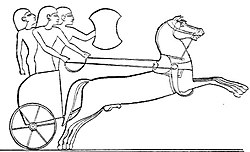Rata: Perbezaan antara semakan
k Link FA & GA kini dikenalikan oleh Wikidata. |
|||
| Baris 78: | Baris 78: | ||
[[Kategori:Zaman Besi]] |
[[Kategori:Zaman Besi]] |
||
[[Kategori:Kenderaan perang pada zaman purba]] |
[[Kategori:Kenderaan perang pada zaman purba]] |
||
[[pt:Carro de guerra]] |
|||
Semakan pada 21:47, 10 September 2015



Rata adalah sejenis pedati kuda yang paling awal dan ringkas. Ia digunakan di waktu aman dan perang sebagai ketua kenderaan dari kebanyakan orang purba. Pedati lembu dan rata-proto telah dibina di Mesopotamia seawal tahun 3000 SM. Rata kuda asal adalah laju, ringan, terbuka, beroda dua atau empat dan ditarik oleh dua atau lebih ekor kuda yang diikat sebelah-menyebelah. Rata, dengan dipandu oleh seorang penunggang rata digunakan dalam peperangan purba pada zaman Gangsa dan Besi. Ia biasanya dilengkapi dengan perisai. Kenderaan ini terus digunakan untuk perjalanan, perbarisan dan permainan dan perlumbaan selepas ia tidak digunakan untuk tujuan ketenteraan. Dari segi ketenteraan, penggunaan rata menjadi lapuk setelah usaha-usaha pembiakan untuk menghasilkan kuda cukup besar bagi ditunggang ke medan peperangan.[1]
Lihat juga
- Pemakaman rata
- Perlumbaan rata
- Taktik rata
- Kereta kebal
- Ratha nama Sanskirt untuk rata
- Gerabak perang
- Tachanka
- Kereta kuil
Nota
Rujukan
- Anthony, D. W., & Vinogradov, N. B., Birth of the Chariot, Archaeology vol.48, no.2, Mar & April 1995, 36-41
- Anthony, David W., 1995, Horse, wagon & chariot: Indo-European languages and archaeology, Antiquity Sept/1995
- Di Cosmo, Nicolo, The Northern Frontier in Pre-Imperial China, Cambridge History of Ancient China ch. 13 (pp. 885–966).
- Litauer, M.A., & Grouwel, J.H., The Origin of the True Chariot', "Antiquity" vol.70, No.270, December 1996, 934-939.
- Sparreboom, M., Chariots in the Veda, Leiden (1985).
Bacaan lanjut
- Anthony, David W. The Horse, The Wheel and Language: How Bronze-Age Riders from the Eurasian Steppes Shaped the Modern World Princeton: Princeton University Press, 2007 (ISBN 9780691058870).
- Chamberlin, J. Edward. Horse: How the horse has shaped civilizations. N.Y.: United Tribes Media Inc., 2006 (ISBN 0-9742405-9-1).
- Cotterell, Arthur. Chariot: From chariot to tank, the astounding rise and fall of the world's first war machine. Woodstock & New York: The Overlook Press, 2005 (ISBN 1-58567-667-5).
- Crouwel, Joost H. Chariots and other means of land transport in Bronze Age Greece (Allard Pierson Series, 3). Amsterdam: Allard Pierson Museum, 1981 (ISBN 90-71211-03-7).
- Crouwel, Joost H. Chariots and other wheeled vehicles in Iron Age Greece (Allard Pierson Series, 9). Amsterdam: Allard Pierson Museum:, 1993 (ISBN 90-71211-21-5).
- Drews, Robert. The coming of the Greeks: Indo-European conquests in the Aegean and the Near East. Princeton: Princeton University Press, 1988 (hardcover, ISBN 0-691-03592-X); 1989 (paperback, ISBN 0-691-02951-2).
- Drews, Robert. The end of the Bronze Age: Changes in warfare and the catastrophe ca. 1200 B.C. Princeton: Princeton University Press, 1993 (hardcover, ISBN 0-691-04811-8); 1995 (paperback, ISBN 0-691-02591-6).
- Drews, Robert. Early riders: The beginnings of mounted warfare in Asia and Europe. N.Y.: Routledge, 2004 (ISBN 0-415-32624-9).
- Lee-Stecum, Parshia (2006). "Dangerous Reputations: Charioteers and Magic in Fourth-Century Rome". Greece & Rome. 53 (2): 224–234. doi:10.1017/S0017383506000295. ISSN 0017-3835. Unknown parameter
|month=ignored (bantuan) - Fields, Nic; Brian Delf (illustrator). Bronze Age War Chariots (New Vanguard). Oxford; New York: Osprey Publishing, 2006 (ISBN 978-1841769448).
- Greenhalg, P A L. Early Greek warfare; horsemen and chariots in the Homeric and Archaic Ages. Cambridge University Press, 1973. (ISBN 9780521200561).
- Kulkarni, Raghunatha Purushottama. Visvakarmiya Rathalaksanam: Study of Ancient Indian Chariots: with a historical note, references, Sanskrit text, and translation in English. Delhi: Kanishka Publishing House, 1994 (ISBN 978-8173-91004-3)
- Littauer, Mary A.; Crouwel, Joost H. Chariots and related equipment from the tomb of Tutankhamun (Tutankhamun's Tomb Series, 8). Oxford: The Griffith Institute, 1985 (ISBN 0-900416-39-4).
- Littauer, Mary A.; Crouwel, Joost H.; Raulwing, Peter (Editor). Selected writings on chariots and other early vehicles, riding and harness (Culture and history of the ancient Near East, 6). Leiden: Brill Academic Publishers, 2002 (ISBN 90-04-11799-7).
- Moorey, P.R.S. "The Emergence of the Light, Horse-Drawn Chariot in the Near-East c. 2000–1500 B.C.", World Archaeology, Vol. 18, No. 2. (1986), pp. 196–215.
- Piggot, Stuart. The earliest wheeled transport from the Atlantic Coast to the Caspian Sea. Ithaca, NY: Cornell University Press, 1983 (ISBN 0-8014-1604-3).
- Piggot, Stuart. Wagon, chariot and carriage: Symbol and status in the history of transport. London: Thames & Hudson, 1992 (ISBN 0-500-25114-2).
- Pogrebova M. The emergence of chariots and riding in the South Caucasus in Oxford Journal of Archaeology, Volume 22, Number 4, November 2003, pp. 397–409.
- Raulwing, Peter. Horses, Chariots and Indo-Europeans: Foundations and Methods of Chariotry Research from the Viewpoint of Comparative Indo-European Linguistics. Budapest: Archaeolingua, 2000 (ISBN 9638046260).
- Sandor, Bela I. The rise and decline of the Tutankhamun-class chariot in Oxford Journal of Archaeology, Volume 23, Number 2, May 2004, pp. 153–175.
- Sandor, Bela I. Tutankhamun's chariots: Secret treasures of engineering mechanics in Fatigue & Fracture of Engineering Materials & Structures, Volume 27, Number 7, July 2004, pp. 637–646.
- Sparreboom M. Chariots in the Veda (Memoirs of the Kern Institute, Leiden, 3). Leiden: Brill Academic Publishers, 1985 (ISBN 90-04-07590-9).
Pautan luar
- Ancient Egyptian chariots: history, design, use. Ancient Egypt: an introduction to its history and culture.
- Chariot Usage in Greek Dark Age Warfare, by Carolyn Nicole Conter: Title page for Electronic Theses and Dissertations ETD etd-11152003-164515. Florida State University ETD Collection.
- Chariots in Greece. Hellenica - Michael Lahanas.
- Kamat Research Database - Prehistoric Carts. Varieties of Carts and Chariots in prehistoric cave shelter paintings found in Central India. Kamat's Potpourri – The History, Mystery, and Diversity of India.
- Ludi circenses (longer version). SocietasViaRomana.net.
- Remaking the Wheel: Evolution of the Chariot - New York Times. February 22, 1994.
